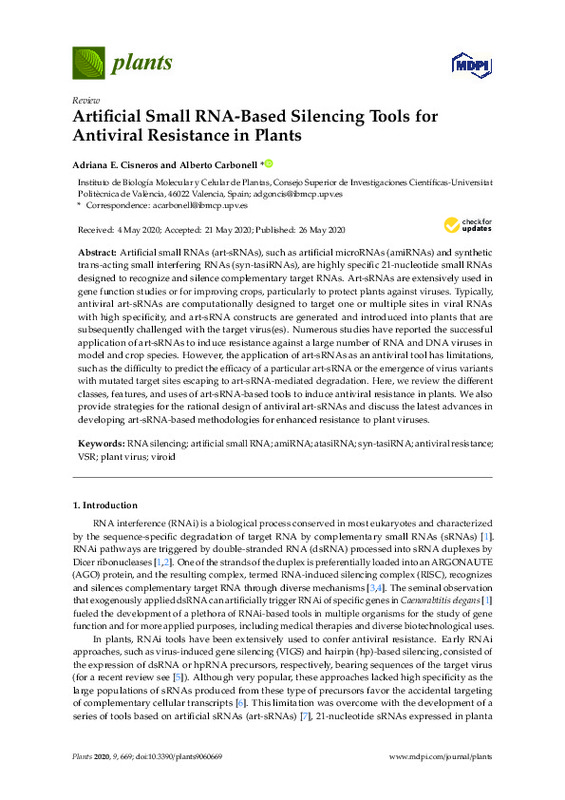Cisneros, AE.; Carbonell, A. (2020). Artificial Small RNA-Based Silencing Tools for Antiviral Resistance in Plants. Plants. 9(6):1-16. https://doi.org/10.3390/plants9060669
Por favor, use este identificador para citar o enlazar este ítem: http://hdl.handle.net/10251/176267
|
Título:
|
Artificial Small RNA-Based Silencing Tools for Antiviral Resistance in Plants
|
|
Autor:
|
Cisneros, Adriana E.

 CARBONELL, ALBERTO
CARBONELL, ALBERTO
|
|
Entidad UPV:
|
Universitat Politècnica de València. Instituto Universitario Mixto de Biología Molecular y Celular de Plantas - Institut Universitari Mixt de Biologia Molecular i Cel·lular de Plantes
|
|
Fecha difusión:
|
|
|
Resumen:
|
[EN] Artificial small RNAs (art-sRNAs), such as artificial microRNAs (amiRNAs) and synthetic trans-acting small interfering RNAs (syn-tasiRNAs), are highly specific 21-nucleotide small RNAs designed to recognize and silence ...[+]
[EN] Artificial small RNAs (art-sRNAs), such as artificial microRNAs (amiRNAs) and synthetic trans-acting small interfering RNAs (syn-tasiRNAs), are highly specific 21-nucleotide small RNAs designed to recognize and silence complementary target RNAs. Art-sRNAs are extensively used in gene function studies or for improving crops, particularly to protect plants against viruses. Typically, antiviral art-sRNAs are computationally designed to target one or multiple sites in viral RNAs with high specificity, and art-sRNA constructs are generated and introduced into plants that are subsequently challenged with the target virus(es). Numerous studies have reported the successful application of art-sRNAs to induce resistance against a large number of RNA and DNA viruses in model and crop species. However, the application of art-sRNAs as an antiviral tool has limitations, such as the difficulty to predict the efficacy of a particular art-sRNA or the emergence of virus variants with mutated target sites escaping to art-sRNA-mediated degradation. Here, we review the different classes, features, and uses of art-sRNA-based tools to induce antiviral resistance in plants. We also provide strategies for the rational design of antiviral art-sRNAs and discuss the latest advances in developing art-sRNA-based methodologies for enhanced resistance to plant viruses.
[-]
|
|
Palabras clave:
|
RNA silencing
,
Artificial small RNA
,
AmiRNA
,
AtasiRNA
,
Syn-tasiRNA
,
Antiviral resistance
,
VSR
,
Plant virus
,
Viroid
|
|
Derechos de uso:
|
Reconocimiento (by)
|
|
Fuente:
|
Plants. (eissn:
2223-7747
)
|
|
DOI:
|
10.3390/plants9060669
|
|
Editorial:
|
MDPI
|
|
Versión del editor:
|
https://doi.org/10.3390/plants9060669
|
|
Código del Proyecto:
|
info:eu-repo/grantAgreement/AEI//RTI2018-095118-A-I00//COMPLEJOS ARGONAUTA1 DE PLANTAS: IDENTIFICACION DE SUS COMPONENTES PROTEICOS Y DE RNA, Y AJUSTE FINO DEL SILENCIAMIENTO MEDIANTE SU PROGRAMACION POR PEQUEÑOS RNAS ARTIFICIALES/
info:eu-repo/grantAgreement/MCIU//RYC-2017-21648//RNA-based regulation of gene expression and antiviral resistance in plants /
|
|
Agradecimientos:
|
This research was funded by grants RYC-2017-21648 and RTI2018-095118-A-100 from the Ministerio de Ciencia, Innovacion y Universidades (MCIU, Spain), Agencia Estatal de Investigacion (AEI, Spain), and Fondo Europeo de ...[+]
This research was funded by grants RYC-2017-21648 and RTI2018-095118-A-100 from the Ministerio de Ciencia, Innovacion y Universidades (MCIU, Spain), Agencia Estatal de Investigacion (AEI, Spain), and Fondo Europeo de Desarrollo Regional (FEDER, European Union) to AC.
[-]
|
|
Tipo:
|
Artículo
|









